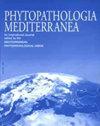四种橄榄品种花发育和果实成熟过程中的炭疽菌感染
IF 1.9
3区 农林科学
Q2 AGRONOMY
引用次数: 0
摘要
橄榄炭疽病是由炭疽菌引起的橄榄炭疽病,是橄榄种植区的重要病害,最具破坏性的症状是果腐病和花枯病。果实对炭疽病的敏感性随成熟度的增加而增加,但品种间和种间的差异已有所报道,但关于发育过程中花对炭疽病敏感性的资料还很少。研究了橄榄树品种Arbequina、Coratina、Frantoio和Picual在花发育和果实成熟过程中对炭素trichum acutatum s.s、C. nyphhaeae、C. fioriniae、C. theobromicola和C. alienum的敏感性。对炭疽病的易感性在花发育的早期阶段开始,在开花期间增加。Arbequina、Coratina和Picual的花敏感,而Frantoio的花中等敏感。青果的炭疽病比成熟果少。青果期,Arbequina和Frantoio最敏感,Coratina为中等敏感,Picual为中等敏感,成熟期各品种间无差异。除可可木炭疽菌(C. theobromicola)在青果期发病最严重外,不同炭疽菌种间无显著差异。未来的研究应侧重于制定炭疽病管理策略,以尽量减少在花发育和果实成熟的早期阶段的疾病进展,特别是在最易感的橄榄品种中。本文章由计算机程序翻译,如有差异,请以英文原文为准。
Colletotrichum infections during flower development and fruit ripening in four olive cultivars
Olive anthracnose, caused by Colletotrichum, is an important disease in olive-growing regions, with the most destructive symptoms being fruit rot and blossom blight. Susceptibility of fruit to Colletotrichum increases with maturity, but differences between cultivars and Colletotrichum species have been reported, still information on flower susceptibility during development is scarce. The susceptibility of the olive cultivars Arbequina, Coratina, Frantoio and Picual was evaluated during flower development and fruit maturity to Colletotrichum acutatum s.s., C. nymphaeae, C. fioriniae, C. theobromicola and C. alienum. Susceptibility to anthracnose begins in early stages during flower development and increases during blossoming. Flowers of Arbequina, Coratina and Picual were susceptible, whereas those of Frantoio were moderately susceptible. Green fruit developed less anthracnose than mature fruit. At the green fruit stage, Arbequina and Frantoio were the most susceptible, Coratina was intermediate, and Picual was moderately susceptible, while no differences were found among the cultivars at mature fruit stages. No mayor differences were found among the Colletotrichum species with exception of C. theobromicola, which caused greatest severity at the green fruit stage. Future research should focus on developing anthracnose management strategies to minimize the disease progress from early stages of flower development and fruit ripening, especially in the most susceptible olive cultivars.
求助全文
通过发布文献求助,成功后即可免费获取论文全文。
去求助
来源期刊

Phytopathologia Mediterranea
生物-植物科学
CiteScore
4.40
自引率
8.30%
发文量
28
审稿时长
6-12 weeks
期刊介绍:
Phytopathologia Mediterranea is an international journal edited by the Mediterranean Phytopathological Union. The journal’s mission is the promotion of plant health for Mediterranean crops, climate and regions, safe food production, and the transfer of new knowledge on plant diseases and their sustainable management.
The journal deals with all areas of plant pathology, including etiology, epidemiology, disease control, biochemical and physiological aspects, and utilization of molecular technologies. All types of plant pathogens are covered, including fungi, oomycetes, nematodes, protozoa, bacteria, phytoplasmas, viruses, and viroids. The journal also gives a special attention to research on mycotoxins, biological and integrated management of plant diseases, and the use of natural substances in disease and weed control. The journal focuses on pathology of Mediterranean crops grown throughout the world.
The Editorial Board of Phytopathologia Mediterranea has recently been reorganised, under two Editors-in-Chief and with an increased number of editors.
 求助内容:
求助内容: 应助结果提醒方式:
应助结果提醒方式:


